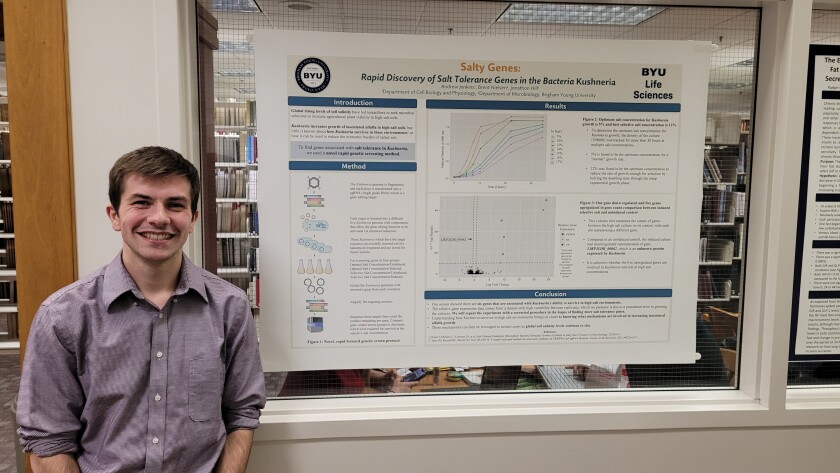The Harold B. Lee Library played host for this year’s College of Life Sciences poster competition. Presenters, friends, family, and a panel of judges made the turnout so successful that it was hard to hear the student presenters over all the excited chatter. Each contestant stood next to their poster, ready to give a taste of their research to anyone who wanted to stop and listen.

First-place winner Andrew Jenkins (CELL ’24) presented his poster on his research, Rapid Discovery of Salt Tolerance Genes in the Bacteria. Rising salt levels in soil around the globe have led researchers to seek microbial solutions to keep plants alive in salty soil. Jenkins used alfalfa, one of the nation’s most prominent crops, to test the possibility that Kushneria, a bacteria found in desert plants, increases plant growth in salty soil.
Jenkins found that Kushneria increases the growth of alfalfa in soils with high salinity levels. His research could be important to people growing crops that wouldn’t normally survive in salty environments. He said presenting his poster was an inspiring opportunity to explain his research to people outside the lab. “If you’re really enthusiastic, engaged, and able to explain things simply, people will get excited,” Jenkins said.

The second-place winner, Natalie Wride (BIO ’23), presented the research she conducted off the shores of Molokai, Hawaii. Wride had the opportunity to go on BYU’s Pacific ecology internship in the spring of 2022, where she spent two weeks in Molokai taking photos and videos of the reef and the species that inhabit it. Wride took inspiration from her internship to study the coral reefs along Hawaii’s southern shores. She hypothesized that coral coverage in Molokai had decreased significantly from 2007 to 2022.
By analyzing the photos and water measurements from her time in Molokai, Wride was able to confidently say that coral coverage has been decreasing. Spots along Hawaii’s southern coast that had 100% coral coverage in 2007 now have 0%. “There’s so much diversity and wildlife in these coral reef ecosystems. With the decrease of coral coverage comes a decrease in fish abundance,” Wride said. According to Wride, the people who listened to her presentation often left shocked and asking the big question: Why is this happening? Wride hopes putting this work out will encourage more people to take better care of the environment.
Third place winner Jocelyn Wells (CELL ’24) presented her poster on disrupting the spread of harmful bacteria. According to Wells, Staphlyococcus aureus cells cluster together to create a biofilm, which is the gross material that forms on your retainer and shower head. Staph cells grow to form a grape-like cluster, making them extremely hard for antibiotics to intercept. Wells and her team hypothesized that finding a chemical to suffocate bacteria could successfully break up biofilms and clusters of Staph.
To test her hypothesis, Wells grew bacteria in a dish. After the growth process, she drained the dish to get rid of the excess bacteria and reveal the biofilm left behind. Next, Wells applied a mild detergent to break up the grape-like clusters of Staph. Then, she counted the colonies of bacteria left behind to see how effective the detergent was at separating the bacteria clusters. Wells and her team concluded that a detergent called Triton X-100 was the most effective at breaking up the Staph clusters. For Wells, presenting at the Life Science Poster Competition was an amazing opportunity to summarize her research for those wanting to learn more. “You can be researching something and think that it’s really interesting, but needing to be ready to explain it to others makes you realize how complicated science really is,” Wells said.
The Life Sciences poster competition was a huge success and had the biggest turnout the college has seen yet. The competition is held once a year during the winter semester and is open to the general public to come view and listen.